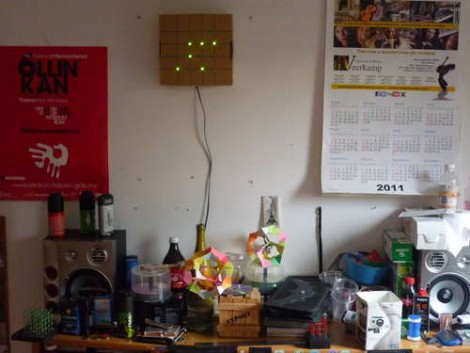
The weekend is almost here and if you’re looking for an afternoon project consider building your own binary wall clock. [Emihackr97] built the one you see above using parts on hand, but even if you put in an order for everything, it won’t cost you much.
He used a cardboard box as the housing for the clock, marking a grid for the LEDs on the face and drilling holes to house them. Two columns for hours and another two for minutes let the clock display 24-hour time with alternate firmware for 12 hour time. Since there are two buttons – one to set hours, the other to set minutes – a little coding would make it possible to select between the two either by clicking both buttons at once, or holding down one button.
[Emihackr97] is driving the display with an ATmega48, which is a pin-compatible replacement for the ATmega168/328. Those chips are the type most commonly found on Arduino boards an indeed this project is running the Arduino bootloader, but uses an ISP programmer and breadboarded circuit to keep the costs low. There are plenty of pins to drive the 13 LEDs directly, making the soldering quick and painless. Check out a demo clip after the break.
If you’re successful at this build and get the itch for something with more style, there’s a ton of ways to spice up the look of a binary clock.
[youtube=http://www.youtube.com/watch?v=XGLL9efyjjo&w=470]















This reminds me of a recent (very) small project I worked on with a digital photo frame:
http://www.youtube.com/watch?v=G712InIBka0
Nice work Emihackr97!
Somebody needs to clean…
Really?
My desk is far messier than that…
Just to stay on topic, my desk has an Anelace binary clock in 24 hour mode.
Just to stay with in the hacking realm, someday I should put a battery backup on it, so it doesn’t reset with every power glitch.
I need to do that same thing. I’ve had to reset the clock to the right time a few times since I’ve made it because of the frequent outages where I live.
Tell me about it:
http://i1127.photobucket.com/albums/l635/flaggfox/2011-09-18204320.jpg
Now THAT’S more like it!
If its just using an atmega for timeeeping, I wonder how accurate it stays over time.
Definitely going to build something similar. Only using a MSP430 in place of the ATMega. Thanks for the inspiration!
Love the low cost aspect of the project.
Am I the only one who finds it surprising (and even bit disappointing) that most binary clocks are BCD instead of “pure” binary. Nothing wrong with that per se, but I’d prefer the non-BCD variation much more. I don’t really know any place where BCD actually makes any sense at all, but maybe it’s just me…
BCD makes sense in the decimal based human realm.
If “pure” binary, why stick with those “old fashioned” Babylonian Base-60 minutes and hours?
Then your binary clock can count up to
00000000 00000001 01010001 10000000 seconds per day or
00000001 11100001 00110011 10000000 seconds per (365 day) year.
(binary figures obtained with a WRPN Windows calculator)